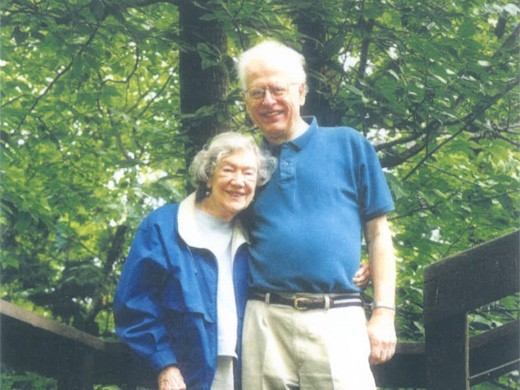From our 2011 Fall Newsletter
November 2011–It’s no secret that Leelanau attracts famous and accomplished people. But beyond those who might immediately come to mind, there are hundreds of other fascinating and highly accomplished figures walking our beaches. It’s one more thing that makes Leelanau so unique. Clarence and Ruth Roy certainly would have fit that bill.
By all accounts the Roys were as engaging as they were accomplished. Clarence was co-founder of one of the largest and most influential landscape and planning firms in the United States—Johnson, Johnson and Roy. He helped to establish the Ann Arbor firm and later opened an office in Dallas. The son of a mining engineer from Ironwood, Clarence was a U of M graduate. In 1984 he was named as a Fellow of the American Society of Landscape Architects and worked on projects that received national recognition. His firm, JJR, was a pioneer in solving land use problems.
Ruth was equally as interesting. Born and raised in New Orleans, she enlisted in the Navy a year after Pearl Harbor was bombed, and remained until the conclusion of the war. She then attended New York School of Interior Design and moved to Dallas, where she met Clarence while working on a project. They were married in 1959 and Ruth ran her own design firms in Ann Arbor and Dallas.
One of Ruth’s up-north design touches was to keep a bowl of Petoskey stones in her foyer at their summer home near Leland for visitors to take away as a Leelanau memory. Once a stone was chosen, Ruth would then explain the fossil’s history. She and Clarence collected the stones on daily walks along Lake Michigan.
“They loved the area,” says Richard Bower, the executor of the couple’s estate. “I would get jealous when they would escape the Texas heat every May. They were incredibly wonderful people yet were quiet and unassuming.”
Marlys Bandy agrees. “They were delightful people and so much fun,” she says. She and her husband, Mike, met the Roys on a Leelanau Conservancy birding hike led by Tom Ford, and in subsequent years, always attended our Annual Friends Picnic together. “I’m an avid birder, and they were too, so we hit it off immediately,” says Marlys. The Roys invited the Bandys to dinner at their home, which was called “Aerie.”
It was easy to see why. “The second story looked out onto the treetops,” says Marlys. Clarence had designed the home which Marlys adds “was perfectly planned to save as many beautiful mature trees, ground cover and native plants as possible. Clarence insisted that they should never plant anything non-native.”
Sadly, 10 years after building Aerie, Clarence was diagnosed with brain cancer and died in 2000. Marlys recalls the last time she saw her dear friend Ruth, who put Aerie on the market after Clarence died. When it came time to fly back to Dallas that July, Ruth asked Marlys to take her to the airport. They agreed to meet up at a friend’s home.
At the appointed hour, Ruth didn’t arrive. “We waited and waited, and then we got worried,” says Marlys. Finally Ruth appeared. They sped to the airport. On the way, Marlys learned what had happened. “Ruth had been out on Lake Michigan, scattering Clarence’s ashes,” says Marlys. “She wanted to do this for him, by herself.”
Ruth never returned to Leelanau. “She could not bear to be there without Clarence,” says Richard, their executor.
Soon after Ruth died in 2008, we received news of their bequest of $680,000. The Roys had met with Director Brian Price in the past to discuss their options for a planned gift. At one time they had thought they might leave “Aerie” to the Conservancy in a life estate, but when Clarence got sick their plans changed. “Clarence and Ruth talked about how much their time in Leelanau meant to them, and how Leelanau’s landscapes had touched their hearts,’ says Brian. “They felt blessed, and they wanted to make sure that they made a significant contribution to preserve the beauty of the peninsula.”
“They just had that strain to want to give back,” adds Richard. “They felt deeply about the organizations they gave to. The Dallas Arboretum and Botanical Society and the University of Michigan were also among the organizations the Roys supported.
With more than $2 million in unfunded land protection projects pending at the time, the Roys’ bequest was welcome news. “Their gift will help us protect places like Clay Cliffs and three working Leelanau farms,” says Conservancy Director Brian Price. “As we feel they would have wished, the Roys’ legacy will live on in the sort of sweeping landscapes we know they loved.”




